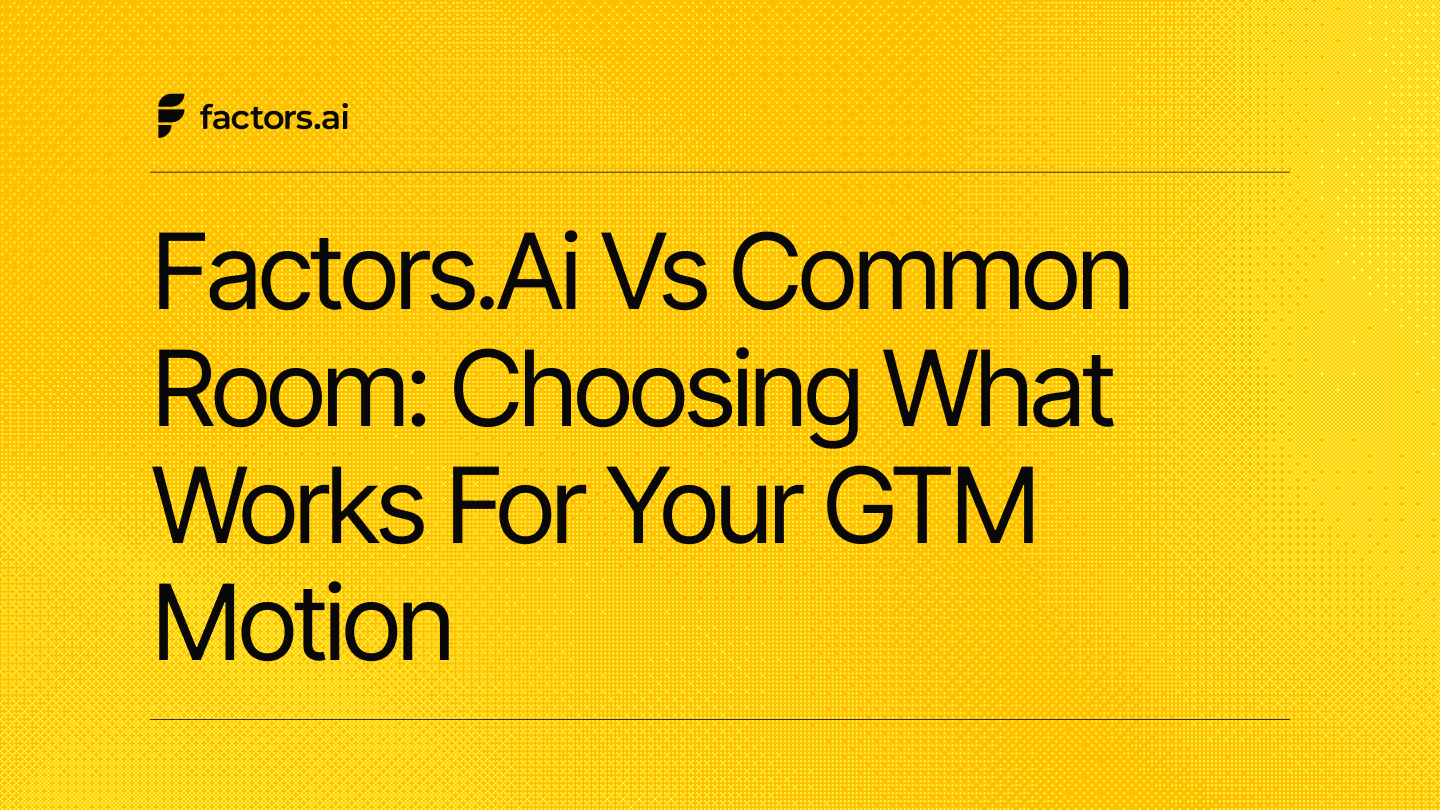Factors vs HockeyStack: Which ABM platform wins?
Compare Factors vs HockeyStack across features, pricing, analytics, AI, and GTM automation. Discover which ABM platform better supports B2B teams.
Choosing the right intent data or ABM platform is never as straightforward as it seems. On the surface, tools often look alike: overlapping features, similar promises, familiar dashboards.
But if you’ve ever sat in a pipeline meeting, you know the real question is about momentum.
- How are the current channels contributing to lead generation?
- How seamlessly can they move from anonymous visitor to active opportunity?
- How confidently can they prove which efforts are driving the real pipeline?
That’s the lens through which we’ll look at HockeyStack and Factors. Two strong platforms, both aiming to give revenue teams more clarity and control. The details of how they help you get there, that’s where the difference reveals itself.
Factors vs HockeyStack: Features and Functionalities
When teams evaluate platforms like HockeyStack and Factors, the first question is always the same: Can this tool actually give me a complete picture of my accounts and how they buy? The strength of a GTM intelligence platform isn’t just about collecting data, but in how that data can be stitched together to tell a useful story.
Both HockeyStack and Factors deliver on the essentials: account identification, journey timelines, segmentation, and scoring, but the depth of what you can do with these capabilities is where things get interesting.
Factors Features and Functionalities
- Bundled account identification
No separate license needed, intent data is available out of the box. Makes it easier to get teams aligned without extra add-ons. - Richer data foundation
Goes beyond 1st and 3rd party signals by bringing in 2nd party data too. That additional layer means a fuller picture of the buying committee. - Advanced scoring with time-weighted signals
Allows you to not only score accounts, but weigh actions differently and define tiers (hot, warm, ice) across longer cycles, up to 180 days. Perfect for complex, enterprise sales where interest builds slowly. - Multi-touchpoint segmentation
Instead of just filtering based on actions, you can group accounts by the full range of interactions across channels. Makes it easier to answer questions like: “Which accounts engaged with both LinkedIn ads and webinar content before booking a demo?”
Why This Matters for Teams
- Marketing leaders can use these capabilities to understand which campaigns are shaping real opportunities, and prove it with journey timelines.
- SDRs and AEs can prioritize outreach based on weighted scores, so they don’t waste time chasing accounts that are cooling off.
- RevOps teams optimize spend and reallocate budget where intent is actually converting.
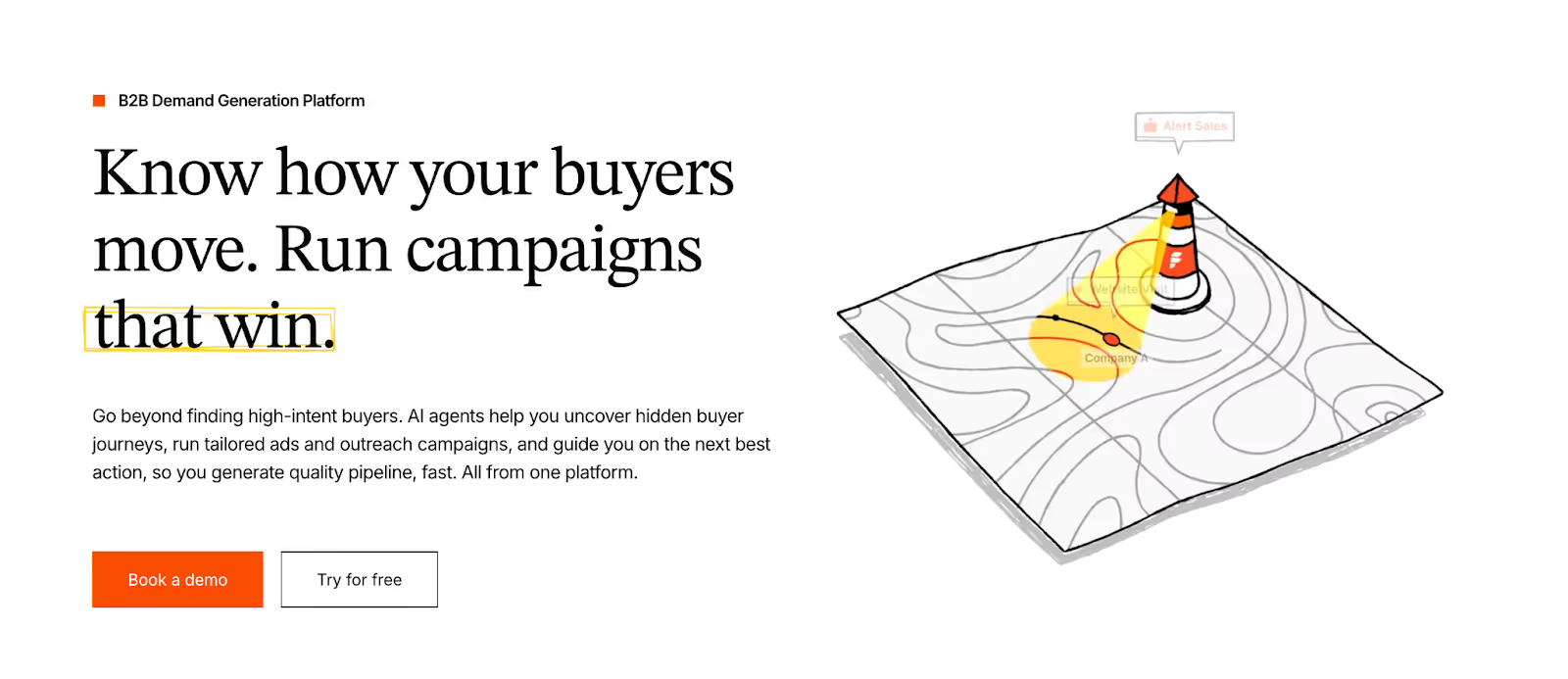
HockeyStack Features and Functionalities
- Account intelligence powered by 1st & 3rd party data
Gives GTM teams visibility into who’s engaging and from where. Great for building top-of-funnel awareness and spotting early intent. - Granular segmentation tools
Filters across dashboards, goals, and properties allow analysts to cut data in multiple ways. For a data-heavy team, this flexibility is powerful. - Custom scoring options
Lets you define what intent looks like by combining firmographic data with behavior signals. Ideal if you want a scoring model tailored to your ICP. - Journey timelines
Clear visual paths of how accounts interact across touchpoints. A good starting point for mapping patterns of buying behavior.
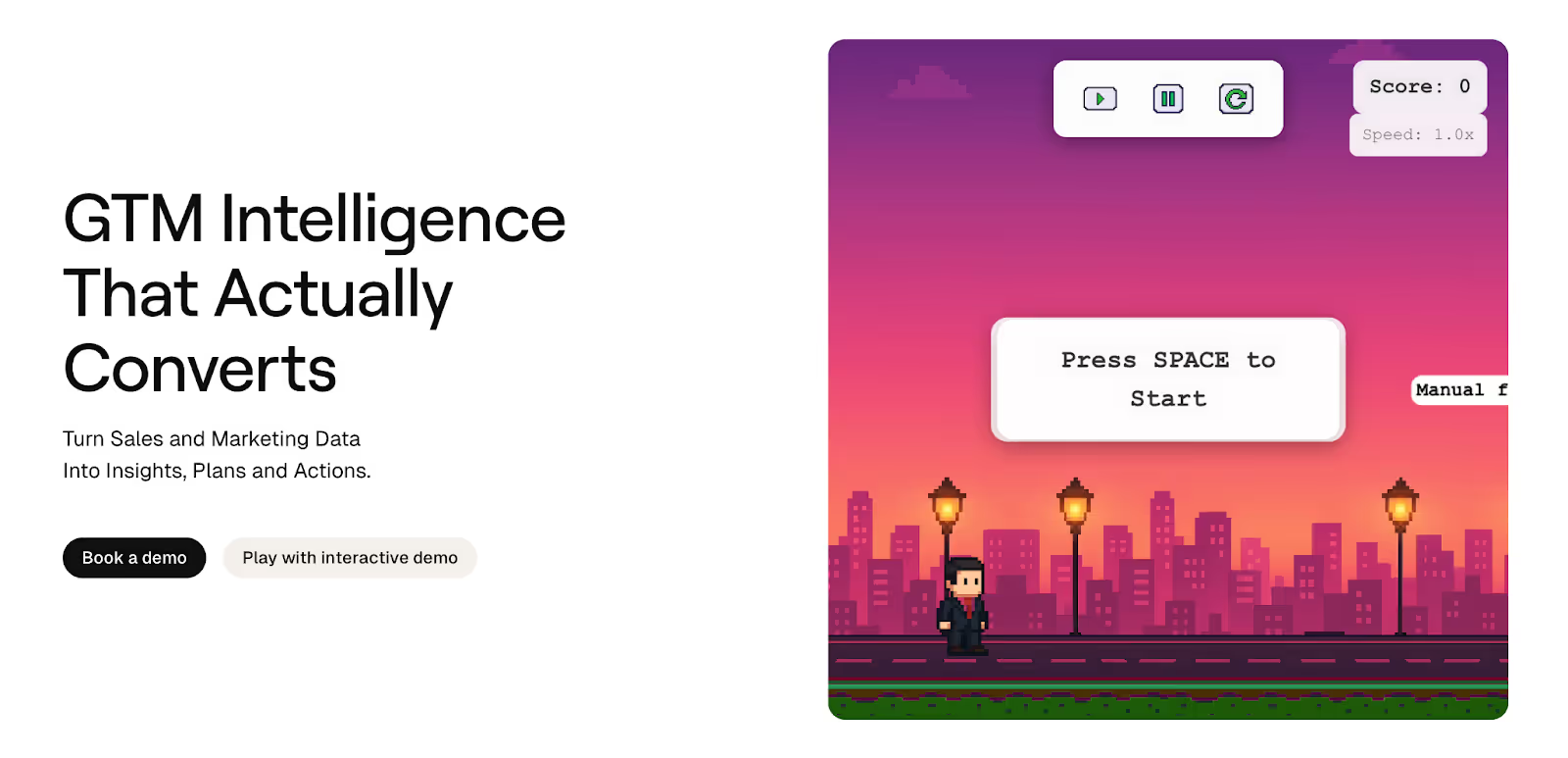
Factors vs HockeyStack: Pricing & Accessibility
Pricing is often one of the first things revenue teams evaluate when considering a GTM platform. Beyond cost, pricing structures reveal how well a tool scales with a team’s growth and usage needs. The right structure ensures that as your GTM operations expand, the platform continues to deliver value without creating friction.
Factors Pricing
Factors organizes its plans around usage, seats, and feature depth, letting teams start small and scale effectively:
- Free Plan
- Designed for exploration: start tracking which companies visit your website
- Analyze basic website traffic
- Set up Slack/MS Teams alerts
- Basic Plan
- Everything under Free, plus:
- Unmask over 75% of companies visiting your website
- Segment accounts using firmographic & behavioral filters
- Track how LinkedIn Ads influence accounts
- Rule-based alerts & workflows to improve sales efficiency
- Build up to 50 reports to monitor key metrics
- Sync data to your CRM
- Everything under Free, plus:
- Growth Plan
- Everything under Basic, plus:
- Complete visibility over the buyer journey
- Custom account scoring and engagement tracking
- Understand how G2 impacts the buyer journey
- Custom agentic alerts & workflows for scaled outreach
- Advanced ABM analytics to track campaign performance
- Everything under Basic, plus:
- Enterprise Plan
- Everything under Growth, plus:
- Predictive account scoring for prioritization
- Increase LinkedIn Ads ROI with impression control & conversion feedback
- Dynamically sync audiences to Google and LinkedIn Ads
- Get high-quality leads from Google Ads with enhanced conversions
- Analyze account behavior across different buyer stages
- Combine 1st, 2nd, and 3rd party data for richer intelligence
- Everything under Growth, plus:
This tiered setup allows teams to pick the plan that matches their current operations while keeping future scalability in mind.

HockeyStack Pricing
HockeyStack's pricing is more straightforward, but it lacks transparency in public disclosure. Based on G2:
- Starting price: ~$2,200/month
- No official breakdown of tiers, seats, or usage limits available on their website
While the starting price is visible, teams may need to contact HockeyStack for detailed quotes, making upfront budgeting less precise compared to Factors’s tiered, transparent model.

Key Takeaways
- Factors offers transparent, tiered pricing.
- HockeyStack has a clear starting cost, but limited publicly available detail makes future budgeting less predictable.
- Teams looking for scalable GTM features bundled with their plan may find Factors easier to plan around and grow with.
Factors vs HockeyStack: Analytics and Reporting
Revenue teams face a flood of data every day, but what really matters are the insights that guide action. Knowing which campaigns to invest in, spotting accounts that are ready to engage, and understanding where the pipeline is slipping through the cracks, these are the questions that drive results.
Both HockeyStack and Factors market themselves as highly customizable, but the way teams use those analytics is what makes the difference.
Factors Analytics and Reporting
- Completely customizable dashboards: Tailored to each team (demand gen, RevOps, sales), without feeling overly complex.
- Advanced segmentation: Goes beyond user-level to include account events, multi-touch journeys, and firmographics.
- Custom account scoring baked in: You’re not just reporting for the sake of it, you’re ranking accounts based on intent signals, CRM activity, and weighted scoring models (hot, warm, cold, etc).
- Multi-touch attribution made practical: Instead of just showing that ads or emails “influenced pipeline,” Factors can break down how much weight each touchpoint carried.
- Data retention & depth: Up to 180 days of signal history, giving marketers a longer look-back window to analyze nurture effectiveness.
Why This Matters for Teams
- RevOps can move from generic dashboards to actionable playbooks, e.g., “These 20 accounts just hit a hot score, route them to SDRs this week.”
- CMOs can defend budget allocation with segment-level comparisons: “Content syndication delivered twice the pipeline efficiency of paid search.”
- Sales leaders can view account timelines without needing an analyst to re-pull data weekly.
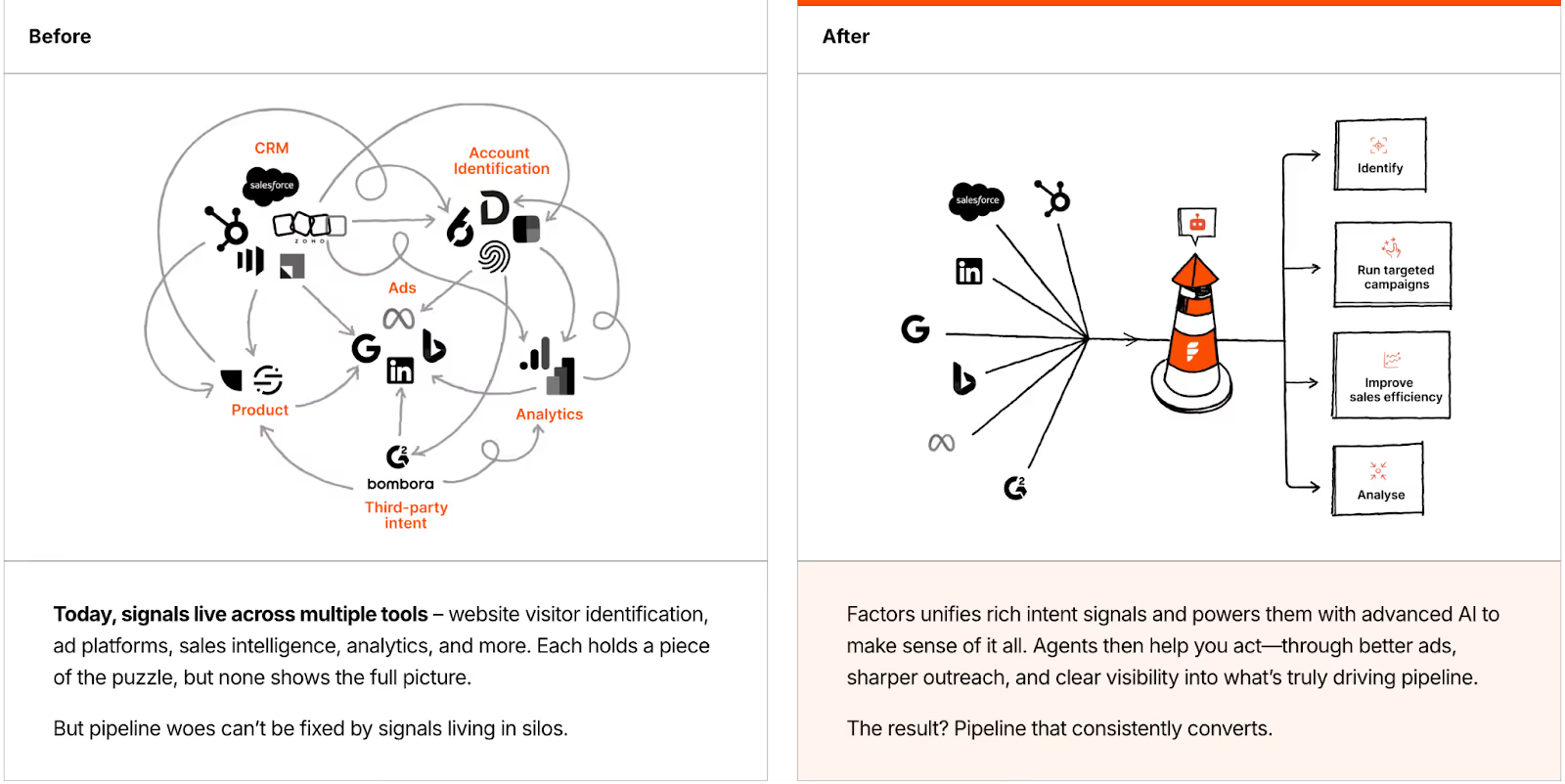
HockeyStack Analytics and Reporting
- Highly customizable views: Teams can configure dashboards and slice data however they like.
- Segmentation power: Multiple levels of filtering (global, column, breakdown, dashboard, and goal filters) allow deep dives into user actions and properties.
- Journey timelines: A visual way to see how accounts moved across touchpoints before reaching key milestones.
- ABM & funnel reporting: Useful for comparing channel and segment performance.
For data-savvy teams, HockeyStack analytics and reporting provides a wide canvas to work with. But this flexibility often means you need ops muscle to structure insights that are useful for sales and marketing leadership.

Factors vs HockeyStack: Workflows and Integrations
Dashboards and insights are only as good as the actions they drive. For GTM teams, that means one thing: the ability to operationalize insights inside the tools they already live in, Salesforce, HubSpot, Slack, LinkedIn, outreach platforms, and so on.
Both HockeyStack and Factors connect the dots here, but their approaches open up slightly different possibilities.
Factors Workflows and Integrations
- CRM contact and deal updates: Syncs with Salesforce and HubSpot just like HockeyStack.
- Built-in enrichment: Leverages Apollo to add context around accounts, so reps aren’t starting cold.
- Sales engagement integrations: Connects with HeyReach, SmartLead, and other outreach tools, moving beyond CRM into the sales execution layer.
- Custom workflows with webhooks: Teams can create automated triggers, e.g., “If an account score hits Hot, add them to a SmartLead sequence and notify the AE in Slack.”
- Multi-channel alerts: Notifications can go to Slack and Microsoft Teams, ensuring sales doesn’t miss signals.
Why This Matters for Teams
- Marketers can directly push audiences into ad platforms or nurture workflows instead of manually exporting CSVs.
- Sales teams get alerts where they already work (Slack, Teams) and can jump into action faster.
- RevOps gains the flexibility to stitch Factors into a broader stack without needing one-off connectors or custom dev time.
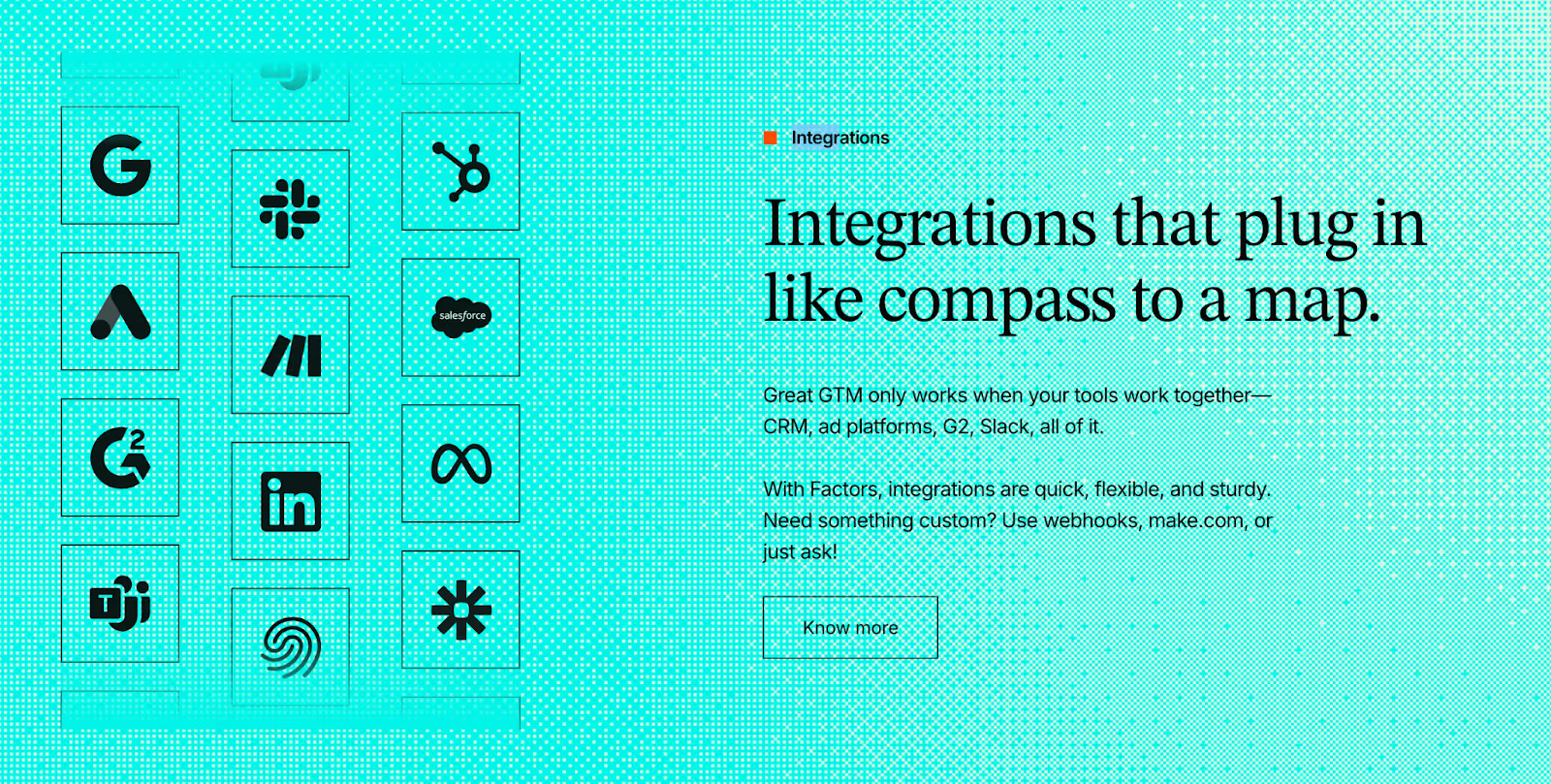
HockeyStack Workflows and Integrations
- CRM syncs: Updates contacts, companies, and deals directly inside HubSpot and Salesforce.
- Marketing automation hooks: Pulls form fills, campaign data, and meeting activity from HubSpot into reporting views.
- Sales data sync: Maps account, contact, lead, and deal objects to keep CRM clean and usable.
- Custom enrichment: Lets teams bring in firmographic and intent data for advanced segmentation.
For teams who rely heavily on Salesforce or HubSpot, HockeyStack does a solid job of bridging insights back into the CRM without requiring constant exports.

At this point, it’s clear: HockeyStack helps with CRM alignment, while Factors extends workflows into the broader GTM stack, including enrichment, outreach, and flexible automation.
Factors vs HockeyStack: AI & Automation
Every GTM team has more signals, more data, and more campaigns than they can realistically handle. That’s where AI enters: to actively help teams prioritize, plan, and execute. Both HockeyStack and Factors lean into AI, but the philosophy and scope of what you can automate are very different.
Factors’ AI & Automation
Where Factors pulls ahead is in pushing AI beyond analysis into execution. Its platform introduces AI Agents and GTM Engineering, programmable teammates that analyze signals and actively take action across the GTM motion.
Some real-world ways Factors’s AI helps teams:
- Account Research at Scale: Surfaces key contacts and buying group details automatically, instead of manual LinkedIn or Apollo searches.
- Signal-to-Action Routing: When a target account shows intent, an AI Agent enriches the data, scores it, and pushes it into outreach sequences via HeyReach or SmartLead.
- Custom Playbooks: Teams can build Agents to track specific conditions, e.g., “watch competitor-engaged accounts, pull key contacts, and send to SDR Slack channel.”
- Outreach Automation: Hot accounts can be auto-routed into cadences, ensuring no opportunity goes cold.
- Marketing Copilot (coming soon): A conversational assistant that answers questions like, “Which channels drove pipeline last quarter?” instantly.
GTM Engineering takes this even further by combining AI Agents with GTM services:
- AI-powered alerts notify reps in real-time when an account is ready to talk.
- They enrich buying groups and multi-thread deals automatically.
- They revive closed-lost opportunities and track post-meeting engagement to guide follow-ups.
Together, AI Agents and GTM Engineering position Factors not just as a co-pilot, but as an operator that actively drives deals forward.
Why This Matters for Teams
- Marketing teams save hours by letting AI handle enrichment, scoring, and activation, instead of manually curating lists or analyzing reports.
- Sales teams get proactive guidance on which accounts to chase and why, with timely nudges for outreach and follow-ups.
- Leadership gains visibility into which AI-driven activities are actually driving pipeline, without requiring analysts to crunch numbers every week.
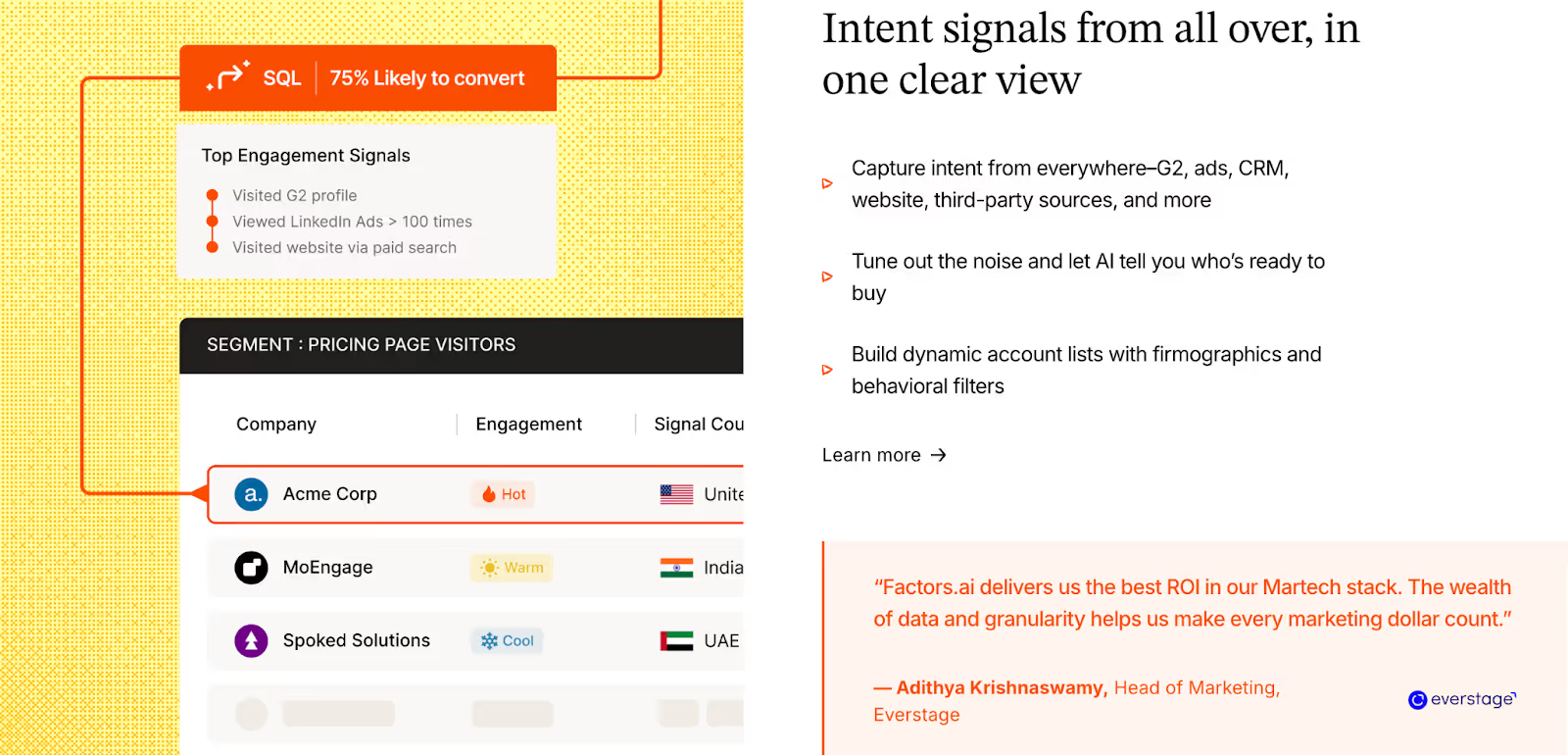
HockeyStack’s AI & Automation
HockeyStack introduces Odin, its AI analyst, designed to make insights faster and more accessible. Odin sits closer to the analysis layer, giving revenue teams quicker answers without needing to through dashboards.
Here’s how Odin helps:
- Campaign Diagnostics: Summarizes which channels are performing well and where conversions are lagging.
- Performance Recommendations: Offers suggestions on targeting, bidding, and budget allocation based on historical campaign performance.
- Faster Reporting: Condenses key takeaways into digestible insights for marketers and sales leaders who don’t want to build complex reports.
For marketers, this reduces dependency on manual reporting. For non-technical users, it lowers the barrier to accessing campaign insights.

In short: HockeyStack helps you see smarter, surfacing insights and recommendations, while Factors helps you act faster, with AI-driven automation and GTM Engineering that turn intent into revenue.
Factors vs HockeyStack: Ads Activation
B2B marketing is about making sure every dollar spent is moving real accounts closer to pipeline. Attribution, syncing, and activation are the levers that decide whether campaigns are just impressions, or actual revenue drivers. Both HockeyStack and Factors recognize this, but the level of depth and orchestration sets them apart.
Factors’ Ad Activation
Factors positions itself as the platform where ad spend directly connects to pipeline, with broader channel coverage and tighter orchestration.
Key capabilities:
- LinkedIn AdPilot: Ad Intelligence for B2B Marketers
Through LinkedIn AdPilot, marketers can orchestrate ads with precision using:- Conversion API (CAPI): Captures server-side and offline conversions that typically slip through native tracking, giving you a complete and accurate view of ROI.
- Impression & Frequency Control: Automatically balances ad delivery across your top accounts so no single account gets overserved, reducing fatigue and wasted spend.
Together, these capabilities help GTM teams move beyond CTRs and optimize for pipeline impact, not just clicks.
💡See how Hey Digital increased their LinkedIn Ads ROI by 35% with AdPilot
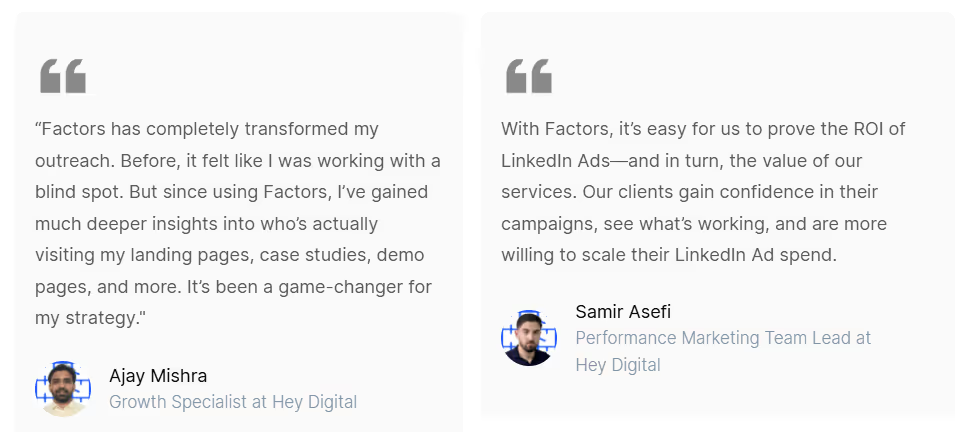
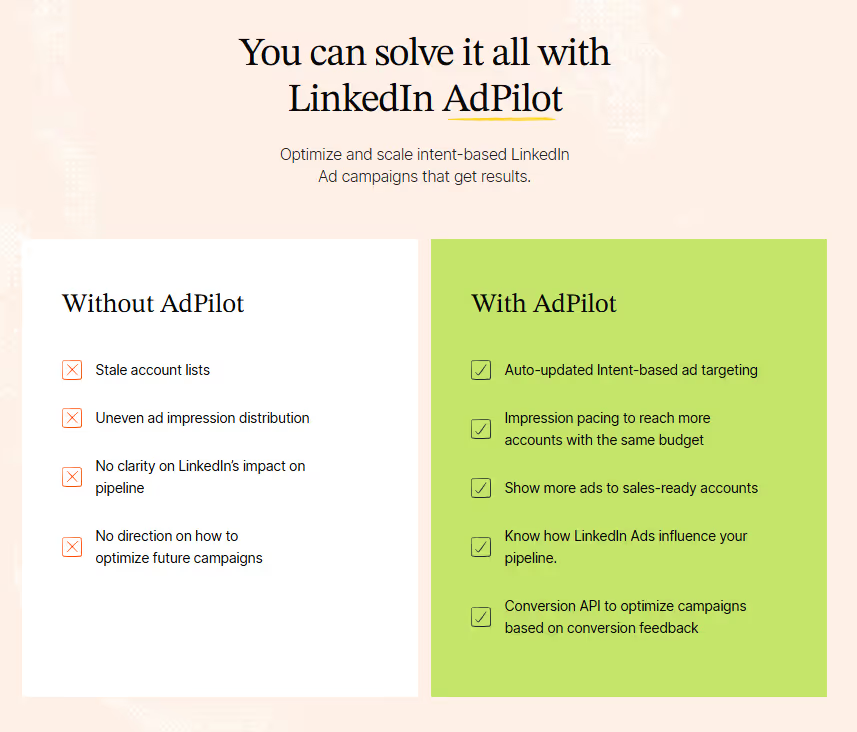
- Google AdPilot
The same intelligence is being extended to Google Ads, bringing B2B precision to the world’s largest ad network.- Audience Sync: Push high-intent accounts from Factors directly into Google Ads for laser-focused targeting.
- Google CAPI Integration: Feed conversion and pipeline data back into Google’s algorithm to train it on what actually drives revenue.
Once live, this will enable full-funnel orchestration across LinkedIn and Google, giving marketers a single, connected view of ad performance and pipeline influence.

- Cross-Channel Orchestration
Factors connects ad interactions with every other engagement signal, webinar attendance, SDR outreach, content engagement, website visits, giving teams a unified view of account journeys.
You can finally see how ad exposure, sales touchpoints, and content interactions compound to move an account from awareness to revenue. - Pipeline Attribution, Not Vanity Metrics
Factors ties every ad campaign to pipeline and revenue outcomes, not surface-level metrics.
- Each ad’s influence is mapped across MQLs, SQLs, opportunities, and closed deals, giving GTM and RevOps teams a clear view into which campaigns accelerate revenue and which ones just drive noise.
- Because it sits on top of account-level intelligence, every ad decision is backed by buying-group behavior, not guesswork.
Why This Matters for Teams
- Demand Gen Managers: Can prove ROI by tying spend directly to influenced pipeline, not just impressions.
- Campaign Ops: Control ad exposure and budget efficiency with tools like frequency pacing.
- RevOps & CMOs: Confidently connect ad spend across LinkedIn and Google to revenue outcomes.
HockeyStack’s Ad Activation
HockeyStack brings ad performance into the GTM picture with a clear focus on LinkedIn.
Key strengths:
- LinkedIn Audience Sync: Retarget the right accounts to keep buying committees warm.
- Offline Conversions → LinkedIn: Push CRM or offline signals back into LinkedIn for better campaign optimization.
- View-Through Attribution: See which ads influenced accounts even without direct clicks.
- Google Ads Activation (coming soon): Expansion is on the horizon, but currently not live.
For teams heavily dependent on LinkedIn, HockeyStack covers the essentials. But beyond LinkedIn, orchestration still feels limited.

TL;DR: HockeyStack gets you started with LinkedIn-focused ad measurement and syncs. Factors extends into true multi-channel orchestration, with deeper LinkedIn controls, pipeline-linked reporting, and Google Ads integrations on the horizon.
Factors vs HockeyStack: GTM Workflows & Automation
Collecting insights is only half the battle. The real power lies in how quickly those insights can be acted upon across your GTM stack. This is where automation makes or breaks efficiency.
Factors’ GTM Workflows & Automation
- CRM Integration: Syncs contacts and deals with HubSpot and Salesforce, but also adds Apollo-based account enrichment for deeper firmographic context.
- Sales Engagement Workflows: Goes beyond CRM, with connections to HeyReach, SmartLead, and similar tools, allowing outreach automation directly from insights.
- Custom Workflows with Webhooks: Offers flexibility to push insights into any tool in your stack, not just the big CRMs.
- Account Prioritization: Uses intent signals and custom scoring to automatically route accounts into the right sequences or cadences.
Why This Matters for Teams
- Marketing Ops: Reduce the burden of manual list uploads and sync mismatches.
- Sales Teams: Get enriched account views and ready-to-action outreach flows without toggling across systems.
- Revenue Leaders: Ensure every high-intent account is engaged quickly and consistently.
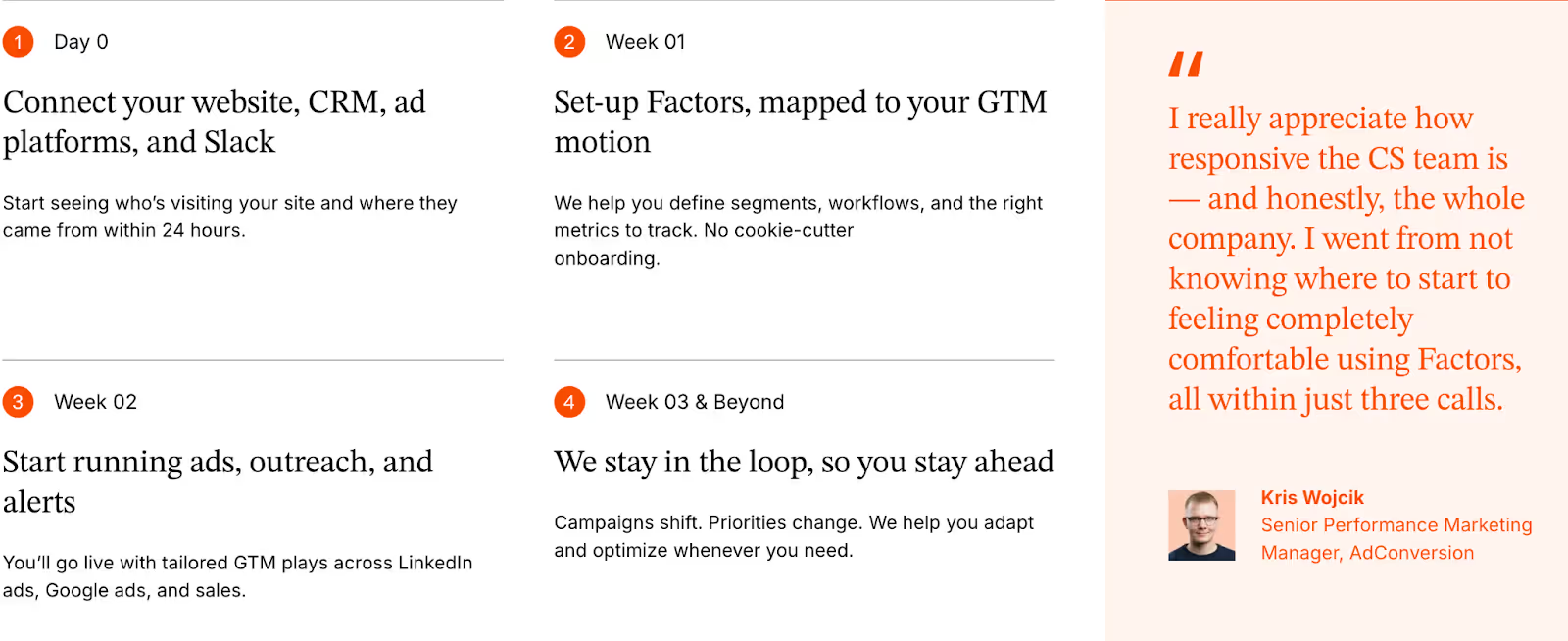
HockeyStack’s GTM Workflows & Automation
- CRM Updates: Automatically updates HubSpot and Salesforce with contact, company, and deal-level information.
- Data Enrichment: Pulls in marketing automation data like forms, meetings, and campaigns to enrich records.
- Custom Segmentation: Supports segmentation with CRM properties, which makes it easier to prioritize accounts.
- Cross-object Sync: Can sync sales data across Accounts, Contacts, Leads, and Deals, keeping revenue data clean.
HockeyStack ensures your CRM stays up to date. Factors extends that foundation, letting you automate the entire GTM motion, from enriched account insights to immediate outreach.
Factors vs HockeyStack: Security and Compliance
When evaluating GTM platforms, flashy features and AI capabilities usually grab the spotlight. But for enterprise teams, the conversation often circles back to a quieter, yet non-negotiable topic: trust. With sensitive customer data flowing through these platforms, security and compliance standards can make or break vendor selection.
Factors’ Security and Compliance
Factors has certifications and practices that resonate with larger organizations, especially those with global footprints.
Here’s what stands out:
- ISO 27001 Certification: A gold standard in information security management, recognized globally and often required by enterprises.
- SOC 2 Type 2: Like HockeyStack, Factors is independently audited for security, availability, and confidentiality.
- CCPA and GDPR: Full compliance with international and regional privacy frameworks.
- Enterprise-grade Governance: Security isn’t just a certification badge, Factors backs it with processes like continuous monitoring, documented policies, and dedicated security reviews for clients.
For companies where IT, legal, and procurement teams scrutinize every vendor, this level of security posture isn’t just a formality, it smooths the buying process and builds long-term confidence.

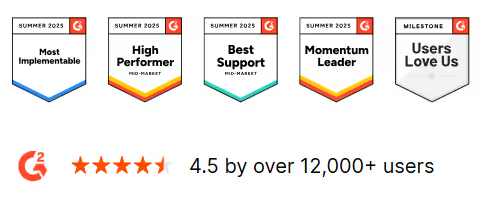
HockeyStack’s Security and Compliance
HockeyStack takes care of core compliance frameworks expected by most SaaS buyers:
- SOC 2 Type 2 Certification: Ensures controls around security, availability, and confidentiality are audited and validated.
- GDPR, CPRA, and CCPA: Compliance with major privacy regulations in the EU and California, covering data rights and consent management.
- Operational Safeguards: Includes processes for data handling, breach management, and regular audits.
For teams that want baseline enterprise security and proof of regulatory alignment, HockeyStack checks the right boxes.
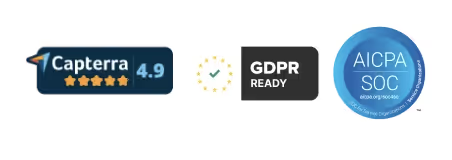
Factors vs HockeyStack: Onboarding and Support
Success with a GTM platform comes from how quickly your team can put its features to work and the quality of support you have along the way. A platform that looks powerful on paper but takes months to implement, or leaves you stranded after sign-up, will never deliver its promised ROI.
Factors’ Onboarding and Support
Factors takes a different tack, leaning into deeply guided onboarding and ongoing support. For growing SaaS and enterprise teams, this often feels less like “buying a tool” and more like bringing in a partner. Their approach includes:
- White-glove onboarding: A dedicated Customer Success Manager (CSM) works closely with your team to configure integrations, map workflows, and ensure data is flowing correctly.
- Dedicated Slack channel: Direct line of communication with the Factors team, ensuring quick responses and real-time collaboration.
- Weekly meetings: Regular check-ins to align progress, answer questions, and adjust strategies.
- Long-term partnership: Beyond initial setup, Factors positions itself as an extension of your GTM team, proactively suggesting improvements and helping scale use cases.
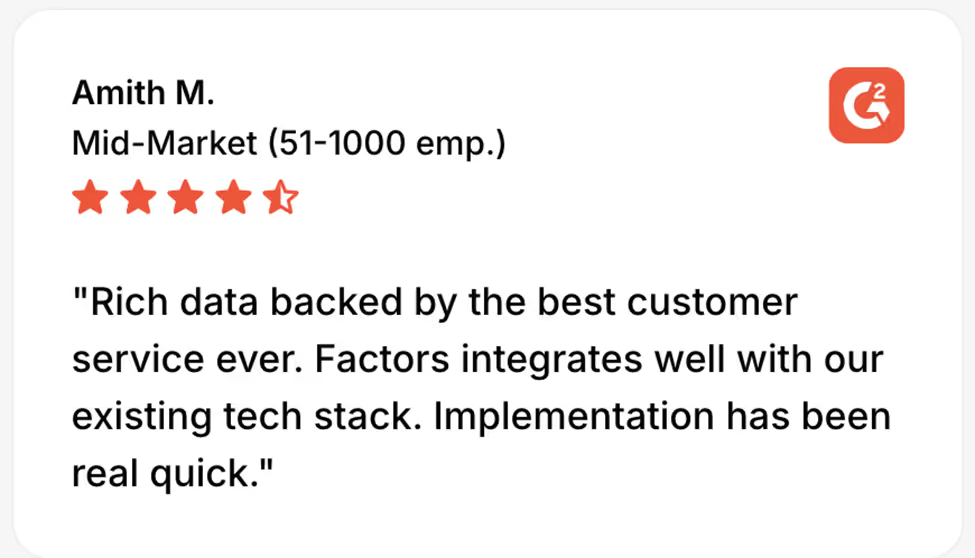
For companies where internal resources are stretched thin, or where the stakes of data-driven GTM are high, this level of hands-on involvement reduces the friction of adoption and speeds up time-to-value.
HockeyStack’s Onboarding and Support
HockeyStack positions itself as relatively straightforward to set up. Their onboarding is built around:
- Self-serve setup with documentation and product guidance.
- Assisted guidance from the HockeyStack team for customers who need help beyond self-service.
- Ongoing support to troubleshoot or advise when teams hit roadblocks.
This model works well for companies with in-house technical resources who prefer to configure and test tools themselves. It also gives autonomy to GTM teams that want to move quickly without waiting on vendor-driven timelines.
Factors vs HockeyStack: Which tool should you choose?
Choosing between HockeyStack and Factors ultimately comes down to the depth of your GTM motion and how your team plans to scale.
Factors is designed for teams that want to go beyond measurement and actively drive pipeline. The platform not only consolidates multi-touch data and offers deeper intelligence with 1st, 2nd, and 3rd party signals, but also bundles account identification natively, automates workflows across CRM and sales engagement tools, and introduces AI Agents and GTM Engineering to turn insights into action. Its tiered pricing, from Free to Enterprise, makes it easy to start small and scale predictably, while white-glove onboarding ensures adoption happens quickly and smoothly.
HockeyStack, on the other hand, is a solid platform for teams focused on analytics, journey views, and actionable insights within a familiar CRM environment. It’s relatively straightforward to adopt and works well for smaller teams or those with strong internal ops resources. The starting price of ~$2,200/month gives clarity on upfront costs, but future scaling may require direct consultation with the HockeyStack team.
Where HockeyStack helps teams see, Factors helps them act, all while providing transparency and flexibility in both functionality and cost.
So, if your priority is…
So, basically...
Choosing Factors as a HockeyStack alternative is about enabling real pipeline impact. Both platforms offer GTM analytics, segmentation, and journey mapping. However, their core philosophies diverge sharply: HockeyStack centers on flexible data views and CRM alignment, while Factors pushes beyond analysis to orchestrate outreach, ad activation, and automated GTM workflows.
Factors comes bundled with account identification, tiered pricing, and integrated AI Agents that trigger actions, not just reports. It combines 1st, 2nd, and 3rd party data with time-weighted scoring and offers native support for LinkedIn and Google ad orchestration. With a built-in enrichment layer and deep integrations into sales engagement tools, Factors turns GTM signals into scalable motion.
By contrast, HockeyStack excels for teams that prefer a self-directed, analytics-heavy setup. Its dashboards and segmentation are highly customizable, though deeper actions often require manual effort or internal ops bandwidth. Pricing starts higher, and expansion paths are less transparent.
In short, if your goal is to activate, not just analyze, your GTM data, Factors provides the tooling, automation, and scalability to execute with clarity and control.
See how Factors can 2x your ROI
Boost your LinkedIn ROI in no time using data-driven insights
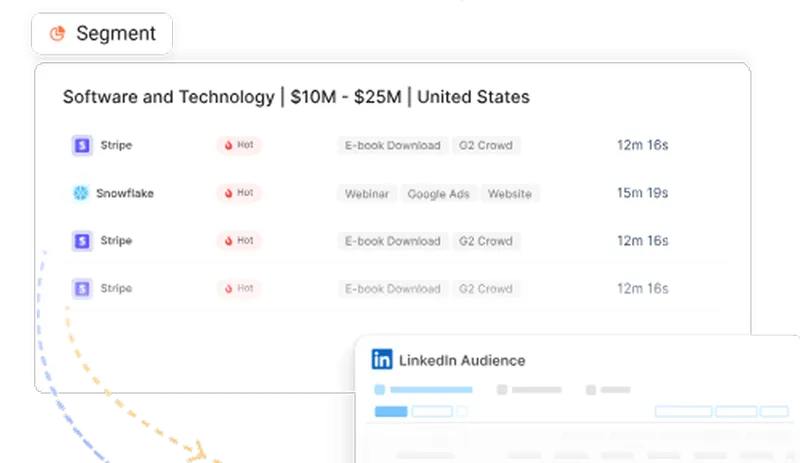
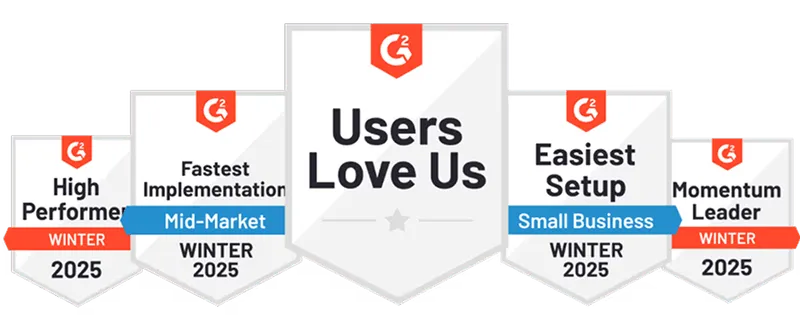
See Factors in action.
Schedule a personalized demo or sign up to get started for free
LinkedIn Marketing Partner
GDPR & SOC2 Type II
.svg)







_%20Which%20ABM%20platform%20should%20your%20team%20choose_.jpg)
